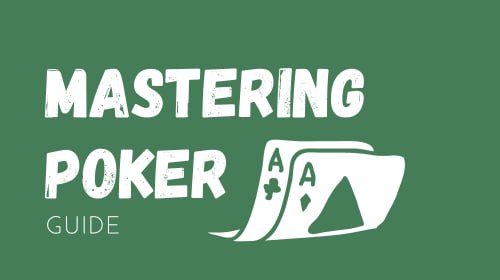
Guide to Mastering the Game of Poker
Poker, a card game steeped in history and intrigue, has evolved from a pastime of the few to a beloved game played by millions worldwide. Known for its unique blend of skill, basic poker strategy, poker techniques, and a bit of chance, poker has established itself as a staple in both casual settings and the competitive world of professional gaming. Its appeal transcends borders, making it a universally recognized and respected game of mental fortitude and tactical acumen.
The essence of poker lies not just in the luck of the draw but also in the strategies employed by players. Mastering poker is akin to a fine art, where understanding the nuances and developing a keen sense of judgment is as crucial as the cards one is dealt. It is a game where psychological insight, patience, and decision-making skills play a pivotal role in determining success. This multidimensional nature of poker makes it not only a game of entertainment but also a compelling mental exercise.
This article aims to be a comprehensive poker guide for both novice and intermediate poker players. It is designed to provide a deep dive into the world of poker, covering everything from the fundamental principles of the game to advanced strategies and psychological tactics. By the end of this online poker guide, readers should have a solid foundation in the basics, as well as insights and tools to enhance their gameplay and elevate their poker skills.
Understanding the Basics of Poker
Poker is more than just a game of cards; it’s a complex mix of basic poker strategy, psychology, and probability. At its core, poker involves players competing to create the best hand or to convince others to fold theirs. Among its numerous variants, Texas Hold’em and Omaha are the most popular, and widely recognized for their strategic depth and accessibility.
In Texas Hold’em, the most well-known variant, each player receives two private cards (hole cards) and uses them in combination with five community cards, revealed in stages, to make the best possible five-card hand. Omaha is similar but starts each player with four hole cards, of which two must be used along with three from the community cards to make a hand.
The ranking of poker hands is universal across most variants, with the Royal Flush (an ace-high straight flush) being the highest possible hand, followed by the Straight Flush, Four of a Kind, Full House, and so on, down to the High Card. Knowing these rankings is fundamental, as it determines the strength of a hand in play.
Understanding the basics of poker guide is crucial for beginners. It’s not just about the rules and hand rankings; it’s also about grasping the essence of the game – the betting rounds (pre-flop, flop, turn, and river in Texas Hold’em), the art of gauging other players’ hands, and the strategy of when to bet, fold, call, or raise. A solid grasp of these principles is the foundation upon which a successfu basic poker strategy is built. For beginners, mastering these basics in our poker guide is the first step in a journey toward becoming a skilled, strategic poker player.
Starting Hand Selection
| Position 📍 | Tight Play Hands 🤏 | Loose Play Hands 🙌 |
|---|---|---|
| Early Position | AA, KK, QQ, JJ, AKs | 1010, AQs, AJs, KQs, AK |
| Middle Position | 99, 88, AQ, AJ, ATs, KJs, QJs, JTs | 77, 66, A9s, KTs, QTs, J9s, T9s, 98s |
| Late Position | Any pair, Any suited connectors | Any A, KQ, KJ, QJ, JT, T8, 97, 86, 75 |
- Importance of Choosing the Right Starting Hands: Selecting the optimal starting hands is critical in setting the stage for later success in a poker hand. Strong starting hands can lead to advantageous positions post-flop, while weak hands can put a player at a disadvantage.
- Guidelines for Tight and Loose Play: Tight play involves selecting only the strongest hands, especially in early positions, to avoid tricky situations. Loose play, suitable for late positions, allows for a wider range of hands, capitalizing on the advantage of having seen others’ actions.
- Positional Awareness: Being aware of one’s position (early, middle, late) is crucial in decision-making. Early positions call for caution, as many players follow, while late positions allow for more flexibility and aggressive play.
Betting Strategy
Understanding Betting Rounds
- Pre-flop: Initial betting round where players decide to call, raise, or fold based on their hole cards.
- Flop: Three community cards are dealt. Players evaluate the strength of their hands with these new cards.
- Turn: A fourth community card is dealt, increasing the potential for stronger hands.
- River: The final community card is dealt. The last opportunity for betting and bluffing.
The Concept of Pot Odds and Expected Value
- Pot Odds: The ratio of the current size of the pot to the cost of a contemplated call. This concept helps players decide whether calling in a particular situation is profitable in the long run.
- Expected Value (EV): A measure of what a player can expect to win or lose on average over the long term for a given action. Positive EV indicates a profitable play, while negative EV suggests a losing proposition.
Bluffing: When and How to Effectively Bluff
- When to Bluff: Ideal situations include when the board suggests a strong hand that you can credibly represent, and when you sense weakness in your opponent.
- How to Bluff: Successful bluffing involves understanding opponents’ tendencies, controlling bet sizes, and maintaining a consistent story that aligns with the community cards and betting history.
List: Key Considerations for Effective Bluffing
- Opponent’s playing style: Tight players are more likely to fold to bluffs.
- Your table image: Bluffing works better if you have a tight image.
- The strength of your hand: Semi-bluffs with the potential to improve are safer.
- Number of opponents: Bluffing against fewer players increases success rates.
- Position: Bluffing from late positions can be more convincing.
- Bet sizing: Your bet should match the story you’re trying to tell.
- Board texture: Dry boards are generally better for bluffing.
- Opponent’s stack size: Players with shorter stacks are more likely to fold.
Reading Opponents and Table Dynamics
In poker, the ability to read opponents and understand table dynamics is as crucial as the knowledge of the game itself. This skill involves interpreting physical cues, betting patterns, and psychological factors to gain an edge over opponents.
- Importance of Observing Opponents’ Tendencies: Successful poker players are adept at noticing patterns in their opponents’ behavior. These patterns can range from how they bet with strong or weak hands, to how they react under pressure. Observing these tendencies allows for tailored strategies against different players, maximizing winning chances.
- Understanding Tells and How to Spot Them: Tells are involuntary reactions that can give away information about a player’s hand. They can be physical (like fidgeting or facial expressions) or pattern-based (like changes in betting speed). The key to spotting is to observe opponents consistently and notice deviations from their normal behavior.
- Adapting to Different Types of Players and Table Dynamics: Poker tables often feature a mix of playing styles – from aggressive to passive, and tight to loose. Recognizing these styles and adapting your play accordingly is vital. For instance, against aggressive players, adopting a more cautious approach can be beneficial, while passive players might allow for more bluffing opportunities. Similarly, table dynamics change as players join or leave; staying adaptable and responsive to these changes is essential for maintaining an advantage.
Bankroll Management
Effective bankroll management is fundamental in poker techniques, ensuring sustainability in the game regardless of its inherent variances.
Importance of Managing Your Poker Bankroll: Proper bankroll management helps in mitigating losses, avoiding the pressure of playing with scarce money, and sustaining a healthy poker career. It’s about maximizing profits while minimizing the risk of ruin.
Guidelines for Choosing the Right Stakes: Your bankroll should dictate the stakes you play, not your skill level or confidence. A common guideline is to have at least 20-30 buy-ins for the level you are playing at. This buffer allows you to withstand the natural swings in the game without going broke.
Knowing When to Move Up or Down in Stakes: Moving up in stakes should be a calculated decision based on consistent winnings and an increased bankroll, not on a whim after a big win. Conversely, it’s crucial to move down in stakes when your bankroll no longer supports the higher level. This fluid movement between stakes, based on financial realities rather than ego, is key to long-term poker success.
Advanced Poker Strategies
Delving into advanced poker strategies involves understanding and implementing concepts that can significantly elevate a player’s game, especially against skilled opponents.
Introduction to Advanced Concepts
- Range Balancing: This is the practice of diversifying the range of hands you play in a given situation to become unpredictable. It involves mixing up your plays with strong, medium, and sometimes weak hands, making it challenging for opponents to read your basic poker strategy.
- Floating: Floating is a sophisticated bluffing technique where a player calls a bet on the flop or turns with a weak hand, intending to bluff on a later street. This move is typically used against players who frequently make continuation bets but often give up on the turn or river.
- Other Concepts: Other advanced poker strategies include understanding implied odds, reversing implied odds, and using blockers (holding cards that may prevent opponents from having specific hands).
Importance of Position and Aggression
Position remains a key factor in advanced play, offering informational advantage and control over the size of the pot. Aggression, when timed correctly, can capitalize on this positional advantage, forcing opponents to make tough decisions.
Adjusting Strategies for Poker Variants
Different poker variants require specific strategic adjustments. For example, in Pot-Limit Omaha, starting hand selection and the importance of drawing to the nuts change significantly compared to Texas Hold’em. Understanding these nuances is critical for success across different games.
Online vs. Live Poker
The transition between online and live poker can be challenging due to key differences in gameplay and environment.
Differences Between Online and Live Poker: Online poker is characterized by a faster pace, the ability to play multiple tables simultaneously, and the absence of physical tells. Live poker, on the other hand, is generally slower, involves more psychological elements like reading physical tells, and often features deeper stack play relative to the blinds.
Adjusting Strategies for Poker Online Play: Online players need to be adept at making quicker decisions and managing multiple tables. The increased hand volume also necessitates a more robust mental game to handle variance. Utilizing poker software for tracking and analysis can also be beneficial.
Advantages and Disadvantages of Both Formats: Online poker offers convenience, a wider variety of games, and a higher hand count for faster learning. However, it can be more susceptible to certain types of fraud, like collusion or the use of prohibited software. Live poker provides a more social and psychological experience, with opportunities to exploit physical tells, but may lack the convenience and game variety of online play. Choosing between the two often comes down to personal preference and goals within the game.
Learning and Improving
In poker, continuous learning and improvement are crucial for staying competitive and profitable. The game’s dynamic nature means poker strategies and player tendencies constantly evolve, requiring players to adapt and refine their skills.
- Importance of Continuous Learning and Self-Review: Regular self-review helps identify mistakes and areas for improvement. Analyzing past hands, especially those that led to significant losses or wins, provides insights into one’s decision-making process and helps in refining strategies.
- Utilizing Poker Books, Online Forums, and Training Sites: A wealth of knowledge is available through various resources. Poker books written by seasoned professionals offer in-depth strategies and theories. Online forums and communities are platforms for discussion, advice, and sharing experiences with fellow poker gamblers. Training sites often provide video tutorials, interactive tools, and professional coaching, offering a structured learning path.
- Keeping Up with the Evolving Strategies of the Game: Poker is not static. Strategies for poker that worked yesterday may not be as effective today. Staying updated with the latest trends, understanding new playing styles, and adapting to the changing dynamics of the game are essential for long-term success.
Practical Tips and Common Mistakes
Successful poker playing is as much about smart strategies as it is about practical, day-to-day habits and avoiding common pitfalls.
Practical Tips for Day-to-Day Play
- Set specific goals for each session.
- Keep detailed records of your play to track progress and identify patterns.
- Stay focused and avoid distractions while playing.
- Manage your time effectively, especially in online play.
- Pay attention to your opponents’ betting patterns and adjust your play accordingly.
Common Pitfalls and How to Avoid Them
- Playing Too Many Hands: Be selective with your starting hands.
- Tilt Control: Avoid playing when emotional, as it can lead to irrational decisions.
- Overvaluing Hands: Understand the relative strength of your hand, especially post-flop.
- Ignoring Table Position: Utilize position as a key factor in your decision-making.
- Underestimating Opponents: Never assume your opponents are weaker players; always play your best game.
Case Studies and Examples
Studying real-life examples and professional poker hands provides invaluable insights into successful strategies and decision-making processes.
- Example of Bluffing Mastery: Consider the famous bluff by Tom Dwan against Phil Ivey in a high-stakes game. Dwan, holding a weak hand, made a significant bet on the river, successfully convincing Ivey, who had a stronger hand, to fold. This illustrates the power of reading opponents and bold bluffing.
- Analyzing a Professional Hand: In the 2003 World Series of Poker, Chris Moneymaker’s all-in bluff against Sammy Farha demonstrated the importance of courage and timing in poker. Despite having a weaker hand, Moneymaker’s confident move led Farha to fold a stronger hand, showcasing the psychological aspect of poker.
- Lessons from Pros: Daniel Negreanu, known for his exceptional reading abilities, emphasizes the importance of observing opponents and adapting to their styles. Phil Hellmuth’s emphasis on playing tight-aggressive poker highlights the value of patience and selecting the right moments to be aggressive.
Conclusion
This online poker guide has traversed the multifaceted landscape of poker, highlighting key poker strategies, poker techniques, practical tips, and the significance of continuous learning. From the foundational aspects like hand selection and betting strategies to advanced tactics and learning from professionals, poker is a journey of ongoing development and adaptation. As players, embracing a mindset of growth and perseverance is essential. Remember, the path to mastering poker is not linear; it’s filled with challenges and learning opportunities. Stay curious, practice diligently, and enjoy the intellectual and competitive richness this timeless game offers./p>









